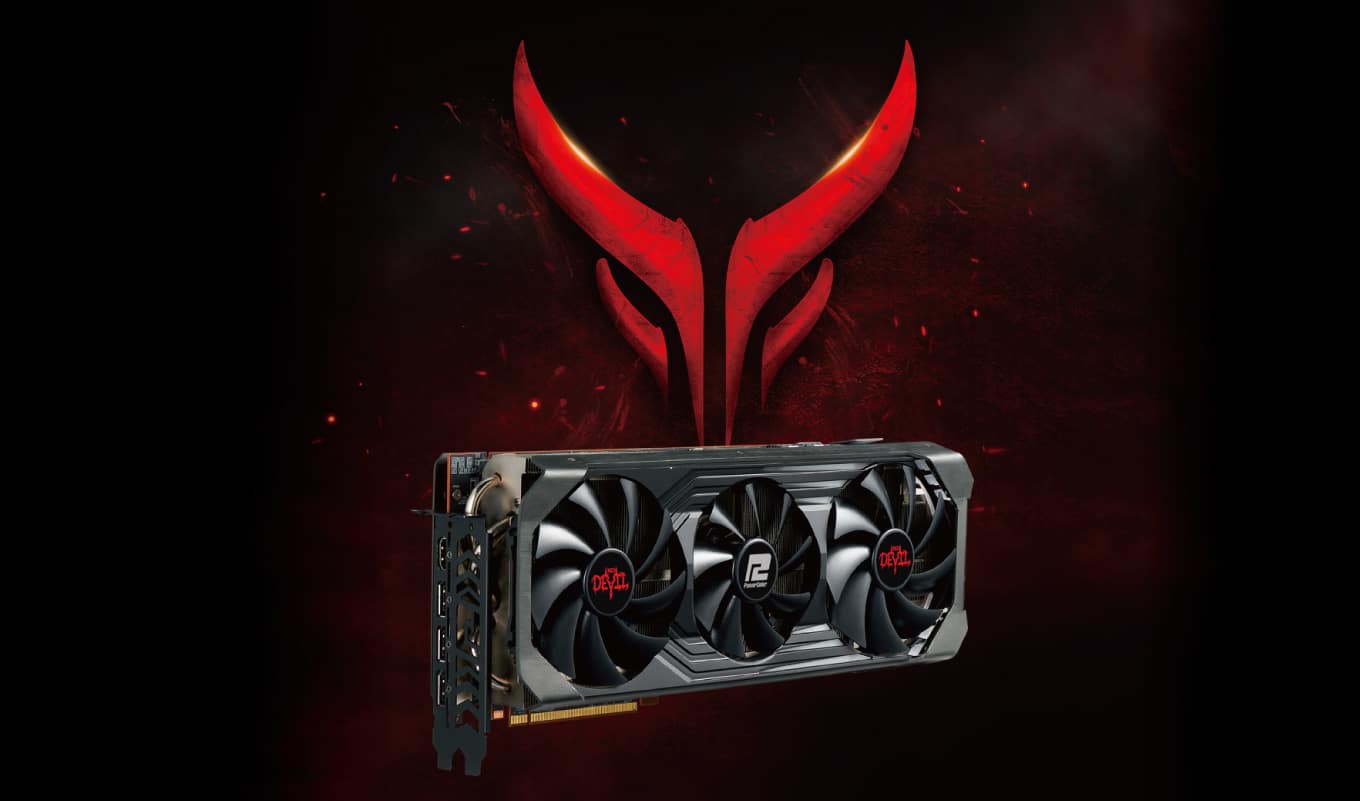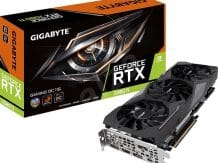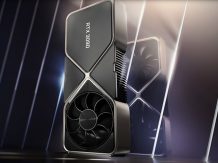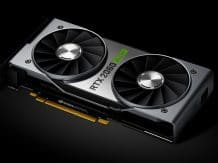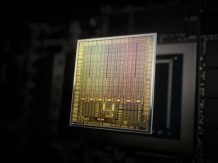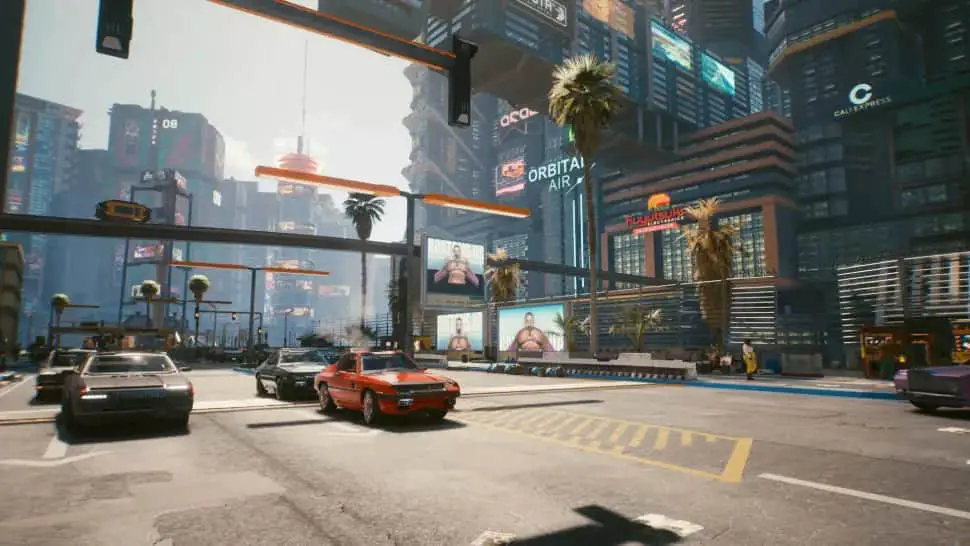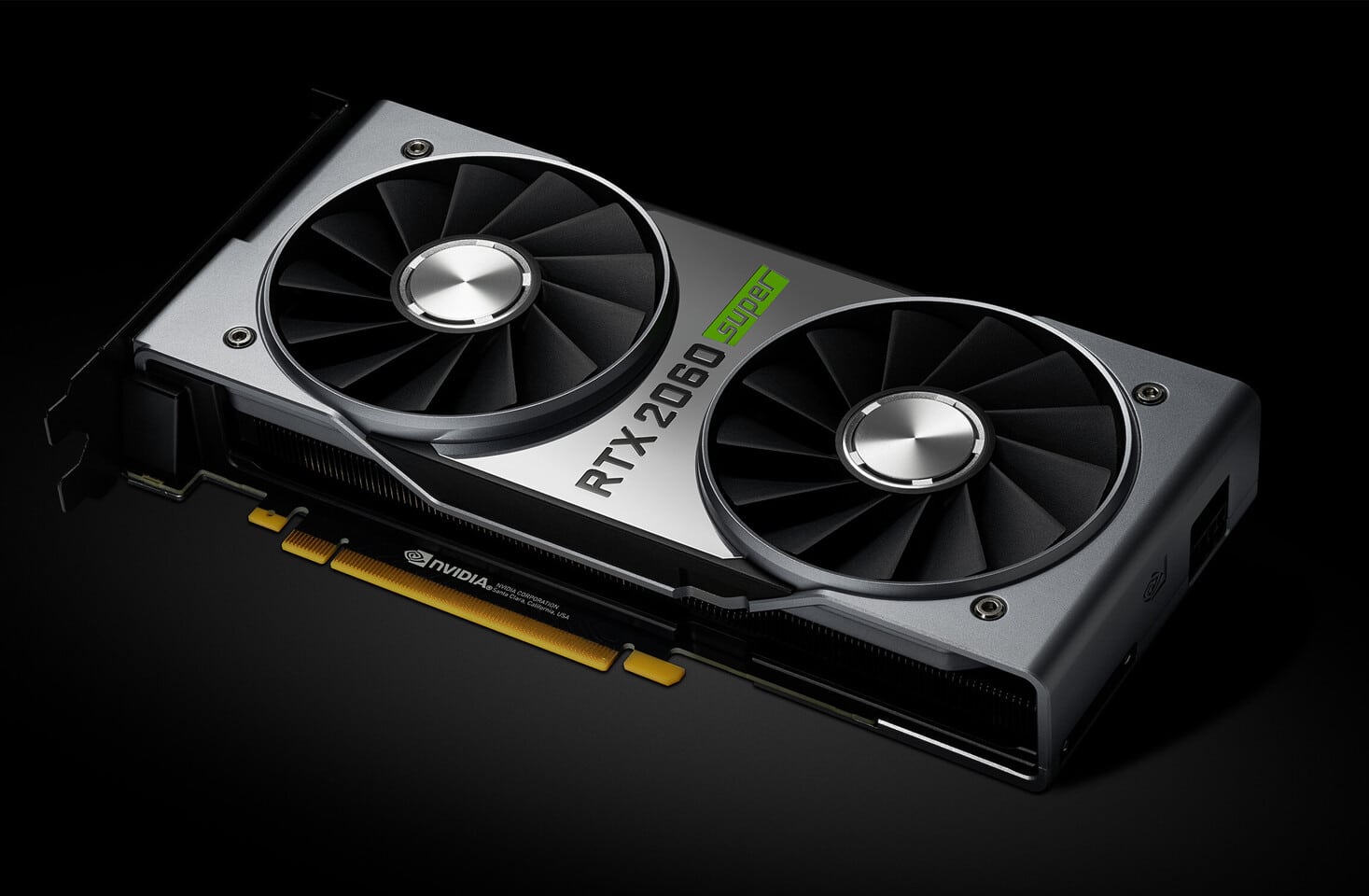Review of PowerColor Red Devil Radeon RX 6800 XT Limited Edition (16 GB): Hashrate | Overclocking Settings | Testing | CPU optimal performance. Check out these and some most common features and specification of the RX 6800 XT.
Object of research : a commercially available 3D graphics accelerator (video card) PowerColor Red Devil Radeon RX 6800 XT Limited Edition 16 GB 256-bit GDDR6.
Many Read This as well – AMD Radeon RX 6800 vs RX 6800 XT: Hashrate | Specs | Test | Config | Profit
Briefly – RX 6800 XT Limited Edition (16 GB)
At the beginning of all reviews of serial video cards, we update our knowledge about the performance of the accelerator family and its competitors. All this is subjectively assessed by us on a scale of five gradations. (This material was prepared prior to the release of the GeForce RTX 3080 Ti).
Nvidia GeForce RTX 3080 and AMD Radeon RX 6800 XT are direct competitors, they demonstrate almost equal performance, allowing you to play comfortably in 4K at maximum graphics settings, but only in games without using ray tracing (RT) – when ray tracing is enabled, the performance of the Radeon 6800 XT could drop to the level of the GeForce RTX 3060 Ti. The PowerColor video card is noticeably more productive than the reference analogue.
Most Read These as Well:
ROG Strix Radeon RX 6700 XT 12 (GB) Review: Hashrate | Overclocking | Testing
Radeon RX 6600 XT Review: Test ( Proven) Specs| Hashrate | Overclocking | Testing
Radeon RX 6800 XT Limited Edition (16 GB) Card characteristics
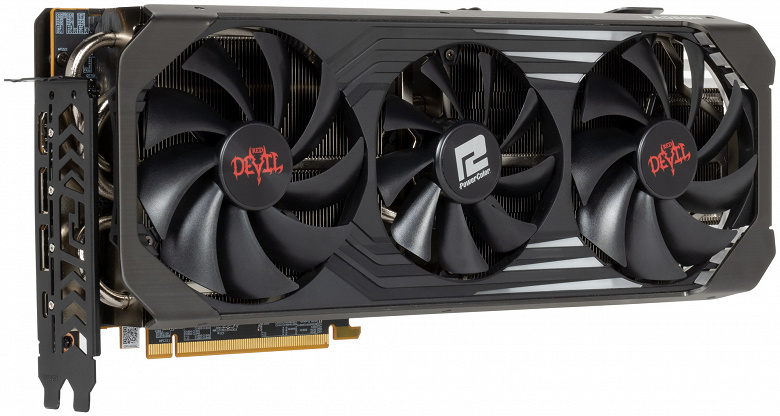
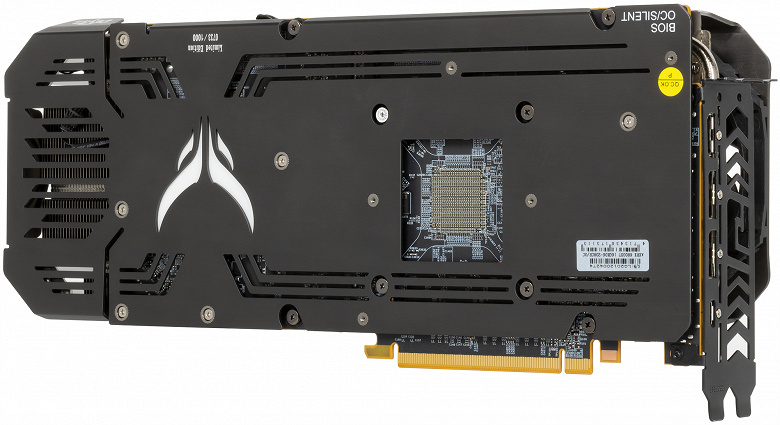
Company TuL Corporation (abbreviation T echnology the U n of L imited), formerly CP Technology (trademark PowerColor). Founded in 1997. Headquartered in Taipei / Taiwan, manufacturing in China (in most cases, Foxconn factories are involved, which owns almost half of TuL’s shares). Until 2002, video cards were produced exclusively based on the Nvidia GPU (GeForce). Starting in 2002, after the reorganization of the company, accelerators began to be produced only based on GPU ATI / AMD (Radeon) .
| PowerColor Red Devil Radeon RX 6800 XT Limited Edition 16 GB 256-DDR6 | ||
|---|---|---|
| Parameter | Meaning | Nominal value (reference) |
| GPU | Radeon RX 6800 XT (Navi 21) | |
| Interface | PCI Express x16 4.0 | |
| GPU frequency (ROPs), MHz | BIOS OC: 2340(Boost)—2436(Max) BIOS Silent: 2250(Boost)—2402(Max) | 2250(Boost)—2401(Max) |
| Memory frequency (physical (effective)), MHz | 4000 (16000) | 4000 (16000) |
| Memory bus width, bit | 256 | |
| GPU Computing Units | 72 | |
| Number of operations (ALU / CUDA) per block | 64 | |
| Total number of ALU / CUDA units | 4608 | |
| Texture units (BLF / TLF / ANIS) | 288 | |
| ROP units | 128 | |
| Number of Ray Tracing blocks | 72 | |
| Number of tensor blocks | — | |
| Dimensions, mm | 320×120×60 | 270×110×55 |
| The number of slots in the system unit occupied by the video card | 3 | 3 |
| PCB color | black | black |
| Peak power consumption in 3D, W (BIOS OC / BIOS Silent) | 264/254 | 269 |
| Power consumption in 2D mode, W | 25 | 25 |
| Power consumption in sleep mode, W | 4 | 4 |
| Noise level in 3D (maximum load) (BIOS OC / BIOS Silent), dBA | 27,7/25,1 | 31,7 |
| Noise level in 2D (video viewing), dBA | 18,0 | 18,0 |
| Noise level in 2D (idle), dBA | 18,0 | 18,0 |
| Video outputs | 1×HDMI 2.1, 2×DisplayPort 1.4a, 1×USB Type-C (USB 3.2 Gen2) | 1×HDMI 2.1, 2×DisplayPort 1.4a, 1×USB Type-C (USB 3.2 Gen2) |
| Multiprocessor support | there is no data | |
| Maximum number of receivers / monitors for simultaneous image display | 4 (including output via USB Type-C) | 4 (including output via USB Type-C) |
| Power: 8-pin connectors | 2 | 2 |
| Power: 6-pin connectors | 0 | 0 |
| Max Resolution / Frequency, DisplayPort | 3840 × 2160 @ 120Hz, 7680 × 4320 @ 60Hz | |
| Max Resolution / Frequency, HDMI | 3840 × 2160 @ 120Hz, 7680 × 4320 @ 60Hz | |
| PowerColor Card Retail Deals |
Memory
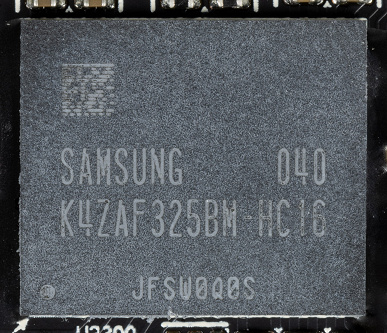
The card has 16 GB of GDDR6 SDRAM located in 8 16 Gbit chips on the front side of the PCB. Samsung memory chips (GDDR6, K4Z80325BC-HC16) are designed for a nominal nominal operating frequency of 4000 (16000) MHz.
Comparison with Radeon RX 6800 XT Limited Edition (16 GB) and AMD Radeon RX 6800 XT 16 GB
| PowerColor Red Devil Radeon RX 6800 XT Limited Edition (16 GB) | AMD Radeon RX 6800 XT (16 GB) |
|---|---|
| front view | |
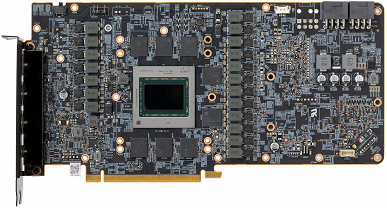 | 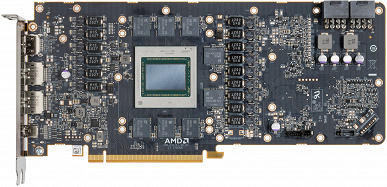 |
| back view | |
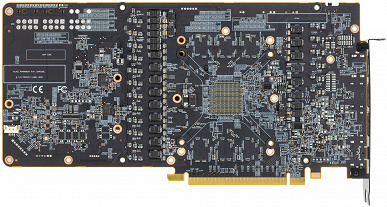 | 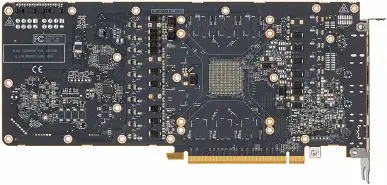 |
If the reference card Radeon RX 6800 XT has a total number of power phases – 15, then the PowerColor card has as many as 19! At the same time, the PCB of the PowerColor card is similar to the reference card only in terms of the location of the memory chips, while the power supply system and so on have been radically redesigned.
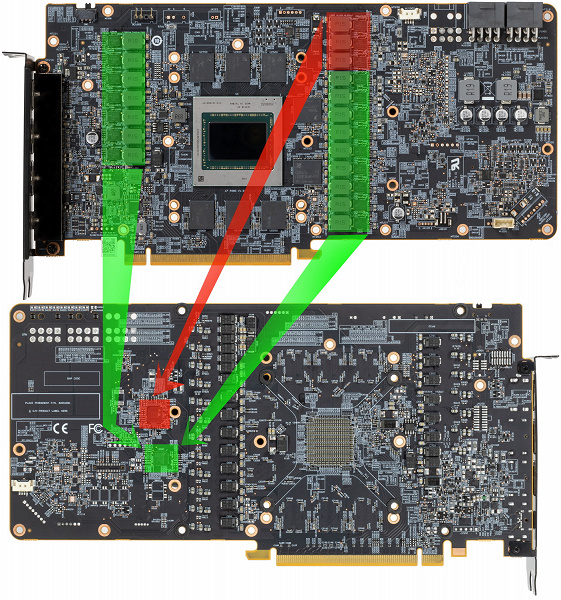
The power supply circuit of the kernel is marked in green, and the memory is in red. The 16-phase PWM controller XDPE132G5D (Infineon) controls 16 phases of the GPU power supply (the controller itself is located on the back of the PCB).
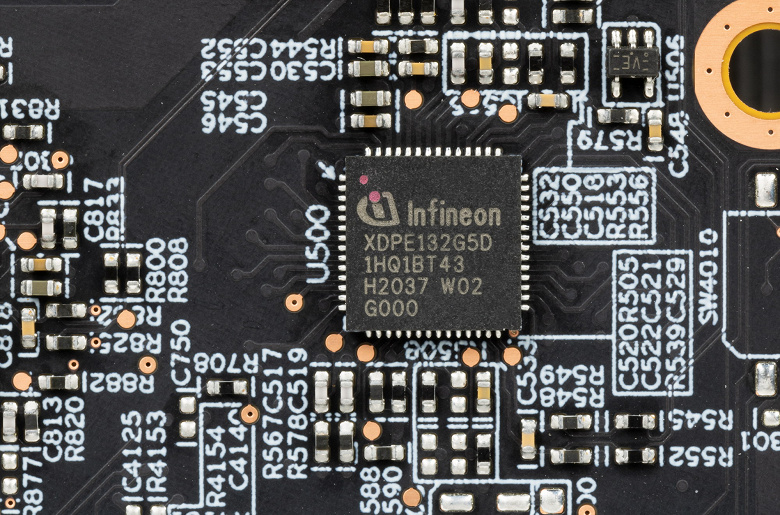
There is also a PWM controller IOR35217 (Infineon / ex-IR), which controls three phases of power supply of memory chips.
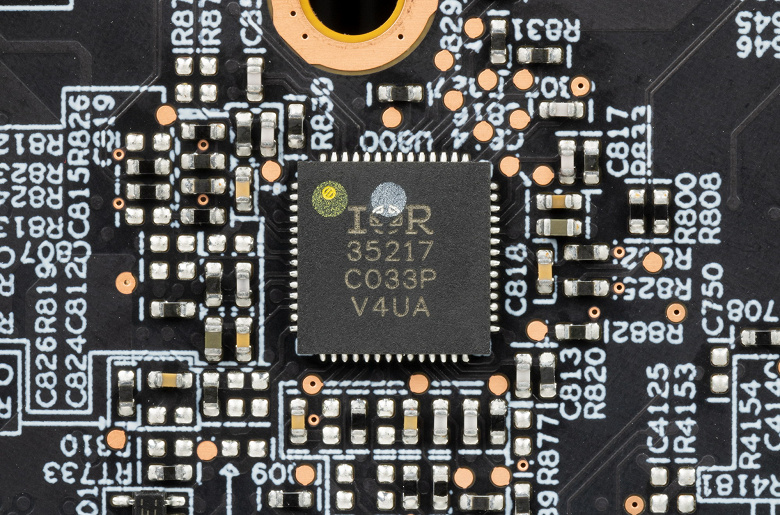
In the GPU and memory power converter, traditionally for all modern video cards, DrMOS transistor assemblies are used – in this case, the very expensive TDA21472 (Infineon / ex-IR).
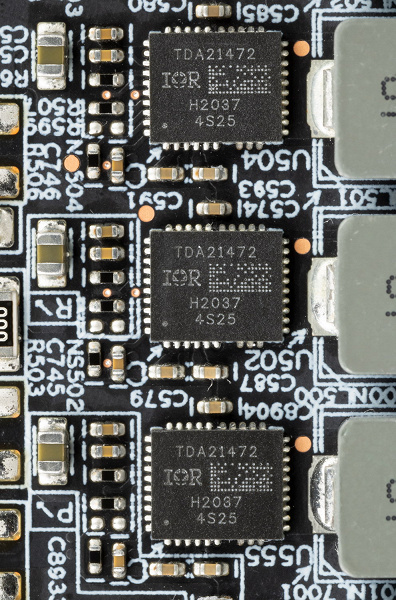
The PCB is very complex with 14 layers including 4 copper layers for improved cooling. (By the way, now there is information that in addition to problems with the supply of rare earth elements for semiconductor production, as well as substrates for chip packaging, there is also a shortage of these same copper sheets for printed circuit boards.) We also see that the card has a set of video outputs recommended by AMD: 1 HDMI + 2 DP + USB Type-C output. The card has a CYPD5137 controller (Cypress Semiconductor), it is responsible for this very USB connector, through which the image output is organized. Thanks to the aforementioned controller, this connector can be used as USB 3.2 Gen2, but its main purpose is universal image output to receivers of various formats: from VR helmets to monitors / TVs with similar inputs.
All video outputs are backlit, so you can connect monitors / TVs in the dark.

There is also a controller for controlling the backlight (it also monitors).
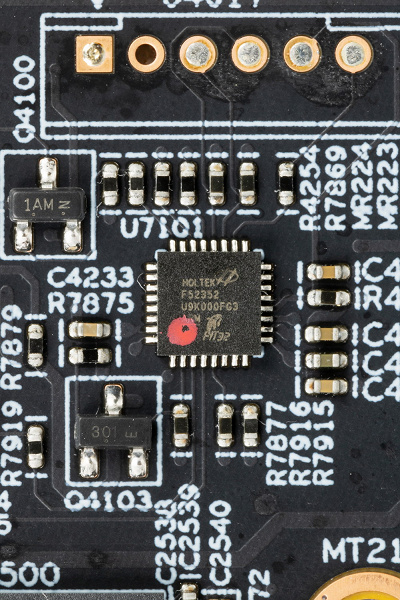
The nominal memory frequencies are equal to the reference values. But the boost value of the core frequency is higher than the reference analogue, which on average gives a performance increase of 3%.
Manual overclocking was tested using the standard AMD utility included in the driver control panel (although overclocking is also possible through MSI Afterburner). While maintaining stable operation, the maximum overclocking was possible up to frequencies of 2725/17088 MHz. At the same time, the performance gain relative to the reference card was 9.5% in 4K resolution.
At low GPU load, the fans always stop. Power is supplied through two 8-pin connectors.
The operation of the card is controlled through the settings in the AMD drivers panel.
Heating and cooling
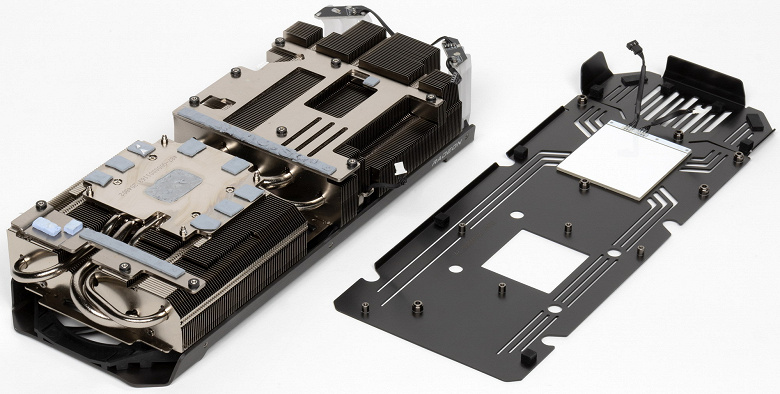
Before us is a large two-piece plate nickel-plated radiator with heat pipes soldered to a nickel-plated base in contact with the GPU and memory chips.
VRM power converters are cooled using separate pads on the same heatsink.
The back graphene plate not only serves as a PCB protection element and a card stiffness amplifier, but also has a backlit Red Devil series logo.
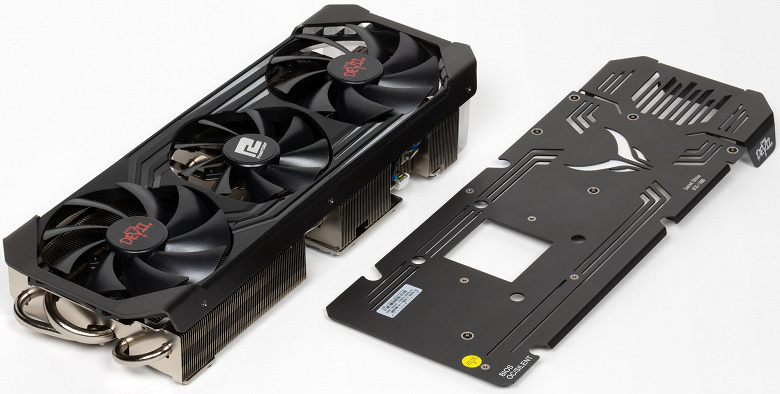
A casing with three fans is installed on top of the radiator: two extreme ∅100 mm and an average ∅95 mm, which have a special curvature of the blades for a more accurate direction of the air flow to the radiator.
The fans stop at low load of the video card if the GPU temperature drops below 50 degrees. Of course, the CO becomes silent at the same time. When the PC starts up, the fans work, but after loading the video driver, the operating temperature is polled, and they are turned off. Below is a video on this topic.
Thermal Monitoring with MSI Afterburner:
BIOS OC
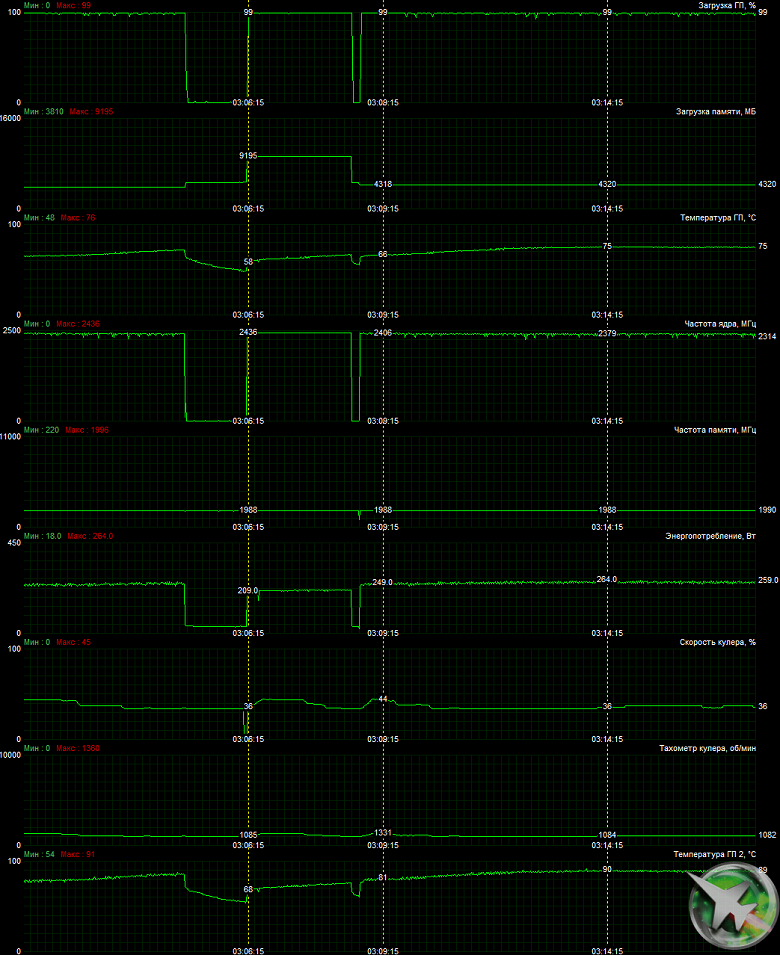
After a 2-hour run under load, the maximum core temperature did not exceed 74 ° C, which is an acceptable result for a video card of this level. The maximum power was recorded at 264W, and the maximum heating was observed in the center of the PCB, and the main heat sources are the GPU and power circuit converters.

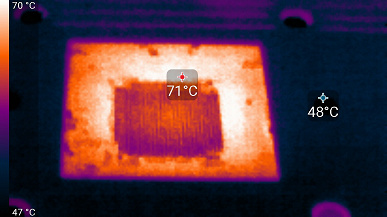
Below is a 9-minute card heating accelerated 50 times.
With the manual overclocking described above, the card’s operating parameters remained almost unchanged, the maximum power consumption rose to 272 watts.
BIOS Silent
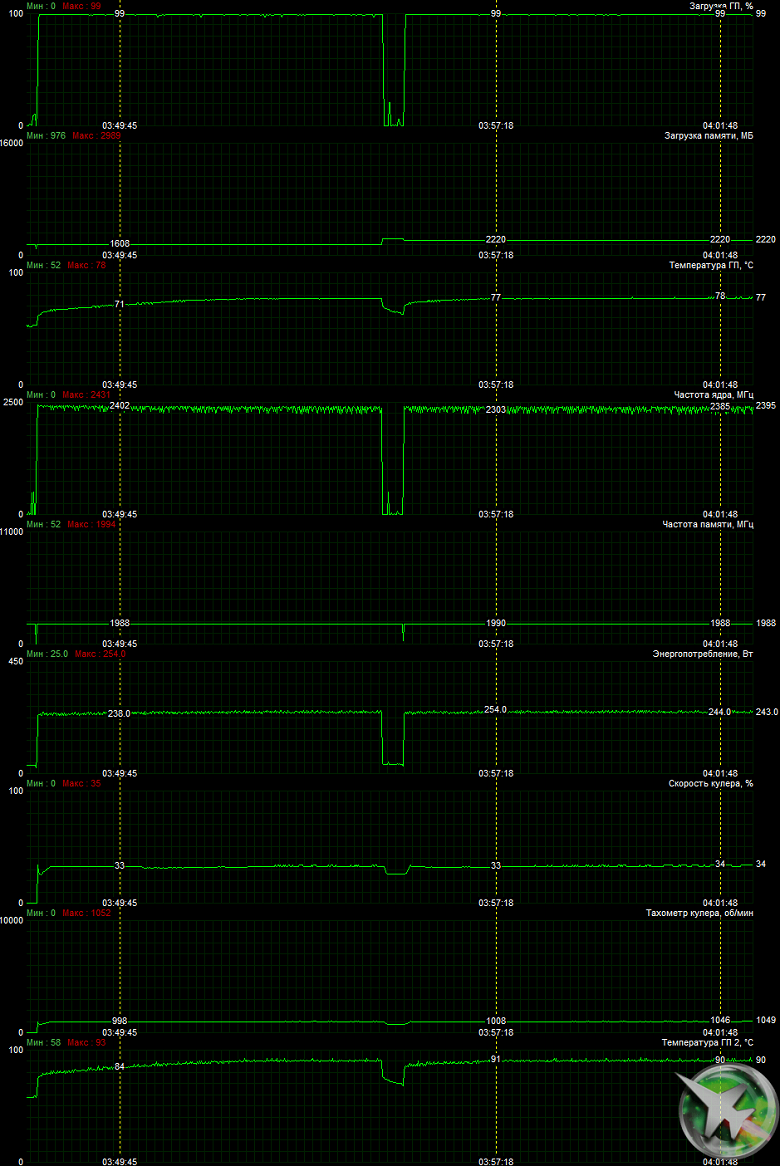
In this case, the maximum core temperature did not exceed 78 ° C, which is probably still an acceptable result for video cards of this level. The maximum power was recorded at 254 watts, while the fan speed dropped sharply.
Separately, we again note that the Radeon RX 6000 series cards have sensors that notify about heating up to 100 degrees and even higher. These sensors can be called Hot Spot or Junction.
The temperature readings from these sensors can significantly exceed the values we are used to when evaluating the heating of the GPU under load. The fact is that the Hot Spot (Junction) is a sensor for the maximum heating of the graphics core. The temperature according to its readings can reach 110 ° C , and it is safe! The driver will continue to increase the frequency of the GPU blocks until the Hot Spot sensor reads close to this critical value. This achieves the maximum that the GPU crystal can provide in the current environment. Of course, a specific chip instance, as well as the type / type, efficiency and mode of operation of the CO, plus the load on the GPU, will affect the possibility of reaching the maximum heating, and hence the maximum operating frequencies. Therefore, these values may differ for different cards, but, we repeat once again, there is no need to be afraid of such temperatures , GPUs tolerate them quite normally (the silicon heating limit is even higher).
Noise
The noise measurement technique assumes that the room is noise-insulated and damped, and reverberations are reduced. The system unit, in which the noise of video cards is examined, does not have fans and is not a source of mechanical noise. The background level of 18 dBA is the noise level in the room and the noise level of the sound level meter itself. Measurements are taken from a distance of 50 cm from the video card at the level of the cooling system.
Measurement modes:
- Idle mode in 2D: loaded internet browser with website, Microsoft Word window, a number of internet communicators
- 2D mode with movie viewing: SmoothVideo Project (SVP) is used – hardware decoding with insertion of intermediate frames
- 3D mode with maximum load on the accelerator: using FurMark benchmark
The assessment of the noise level gradations is as follows:
- less than 20 dBA: conditionally silent
- 20 to 25 dBA: very quiet
- from 25 to 30 dBA: quiet
- 30 to 35 dBA: clearly audible
- 35 to 40 dBA: loud but bearable
- above 40 dBA: very loud
In 2D idle, the temperature was no higher than 36 ° C, the fans did not work, the noise level was equal to the background noise level – 18 dBA.
When watching a movie with hardware decoding, nothing changed.
BIOS OC
Under maximum load in 3D, the core temperature reached 74 ° C, the memory heated up to 80 degrees. At the same time, the fans spun up to 1330 rpm, the noise rose to 27.7 dBA: it’s quiet. In the video below, you can evaluate how the noise grows (it was fixed for a couple of seconds every 30 seconds).
BIOS Silent
Under maximum load in 3D, the core temperature reached 78 ° C, and the memory temperature – 84 ° C. At the same time, the fans spun up to 1050 rpm, the noise grew only up to 25.1 dBA: it’s even very quiet. In the video below, you can evaluate how the noise grows (it was fixed for a couple of seconds every 30 seconds).
It should be remembered that the heat generated by the card remains inside the system unit, so it is advisable to use a case with good ventilation.
Backlight
The card has a highlighted series logo on the back, 6 stripes between the middle and right fans and a stylized set of stripes on the back. The backlight is visible both when the card is installed vertically through the riser, and when it is normally placed horizontally (then the rear logo and end strips are clearly visible).

The backlight is controlled using the proprietary PowerColor utility.

The choice of modes is good. In addition, the card has the ability to synchronize its illumination with the motherboard, for which the card has an ARGB 3V connector on the top end, and a cable for connecting to a similar connector on the motherboard is included in the package. A cable with a splitter, which allows you to connect to it a cable from an existing backlight that was plugged into the same ARGB connector.
In general, the backlighting is not too wide and bright, but very stylish.
Scope of delivery and packaging
The package, in addition to the traditional user manual, includes the aforementioned backlight sync cable, a bonus sticker, and a couple more souvenirs.
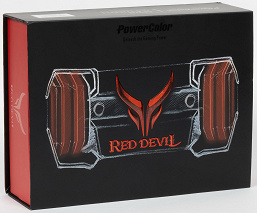
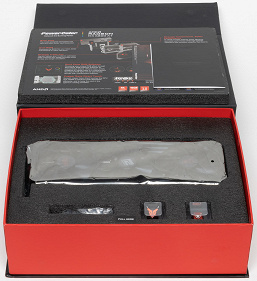
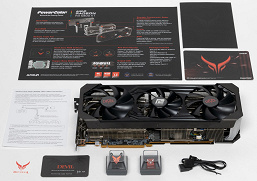
For fans of the Red Devil series, the company supplies two keycaps for mechanical keyboards with branded horn masks in this Limited Edition.
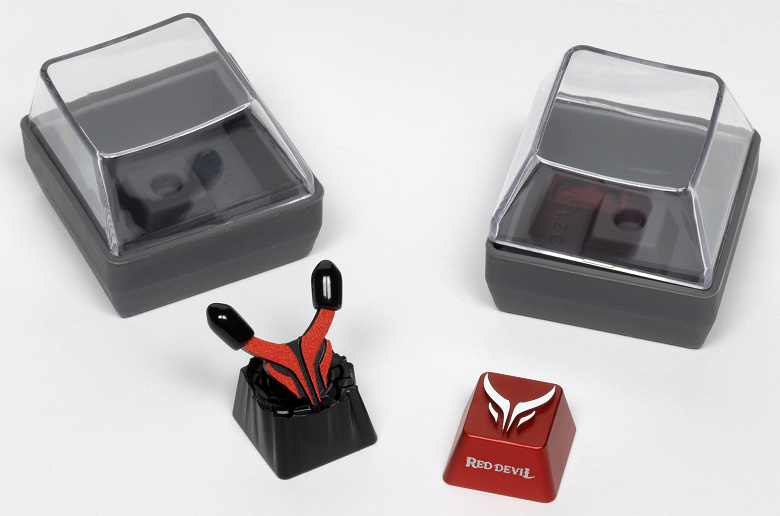
And if the red cap can still be used for a more or less frequently used key, the black “with horns” is only as a decor, which means that it can only be put on the Scroll Lock 🙂
Test results
Test bench configuration
- Компьютер на базе процессора AMD Ryzen 9 5950X (Socket AM4):
- Платформа:
- процессор AMD Ryzen 9 5950X (разгон до 4,6 ГГц по всем ядрам);
- ЖСО Cougar Helor 240;
- системная плата Asus ROG Crosshair Dark Hero на чипсете AMD X570;
- оперативная память TeamGroup T-Force Xtreem ARGB (TF10D48G4000HC18JBK) 32 ГБ (4×8) DDR4 (4000 МГц);
- SSD Intel 760p NVMe 1 ТБ PCI-E;
- жесткий диск Seagate Barracuda 7200.14 3 ТБ SATA3;
- блок питания Seasonic Prime 1300 W Platinum (1300 Вт);
- корпус Thermaltake Level20 XT;
- операционная система Windows 10 Pro 64-битная; DirectX 12 (v.20H2);
- телевизор LG 55Nano956 (55″ 8K HDR, HDMI 2.1);
- драйверы AMD версии 21.5.1;
- драйверы Nvidia версии 466.27;
- VSync отключен.
- Платформа:
Testing tool list
All gaming tests used the maximum graphics quality in the settings.
- Hitman III (IO Interactive/IO Interactive)
- Cyberpunk 2077 (Softclub / CD Projekt RED), patch 1.2
- Death Stranding (505 Games/Kojima Productions)
- Assassin’s Creed Valhalla (Ubisoft/Ubisoft)
- Watch Dogs: Legion (Ubisoft/Ubisoft)
- Control (505 Games/Remedy Entertainment)
- Godfall (Gearbox Publishing/Counterplay Games)
- Resident Evil Village (Capcom/Capcom)
- Shadow of the Tomb Raider (Eidos Montreal/Square Enix), HDR включен
- Metro Exodus (4A Games/Deep Silver/Epic Games)
To calculate the hashrate when mining Ethereum, the T-Rex miner (0.20.01) was used, the average indicator for 2 hours was recorded in two modes:
- by default (consumption limit reduced to 70%, GPU frequency reduced by 200 MHz, memory frequency by default, fans set in manual mode by 70%)
- optimization (the consumption limit is reduced to 70%, the GPU frequency is reduced by 200 MHz, the memory frequency is increased by 500-1000 MHz (depending on the card), the fans are set in manual mode by 80%)
To test the GeForce RTX 3060, we used the same “leaked” driver version 470.05, in which the protection against mining was disabled.
Test results in 3D games
Standard benchmark results without hardware ray tracing at 1920 × 1200, 2560 × 1440, and 3840 × 2160
Assassin’s Creed Valhalla
Shadow of the Tomb Raider
Most games still do not support ray tracing technology, and there are still a lot of video cards on the market that do not support RT in hardware. The same is true for Nvidia’s DLSS smart anti-aliasing technology. Therefore, we still carry out the most massive tests in games without ray tracing. Nevertheless, today already half of the video cards we regularly test support RT technology, so we conduct tests not only using conventional rasterization methods, but also with the inclusion of RT and / or DLSS. It is clear that in this case, video cards of the AMD Radeon RX 6000 family participate in tests without an analogue of DLSS (we are waiting for the company to implement the promised analogue and speed up the calculation of ray tracing).
Test results with hardware ray tracing and / or DLSS enabled at 1920 × 1200, 2560 × 1440, and 3840 × 2160
Cyberpunk 2077, RT+DLSS
Watch Dogs: Legion, RT
Watch Dogs: Legion, RT+DLSS
Resident Evil Village, RT
Shadow of the Tomb Raider, RT
The accelerator rating demonstrates to us the functionality of video cards relative to each other and is presented in two versions:
- Rating option without RT included
The rating is compiled for all tests without the use of ray tracing technologies. This rating is normalized for the weakest accelerator – GeForce GTX 1650 (that is, the combination of speed and features of the GeForce GTX 1650 is taken as 100%). Ratings are carried out for 28 accelerators that we study monthly as part of the Best Video Card of the Month project. In this case, a group of cards for analysis has been selected from the general list, which includes the Radeon RX 6800 XT and its competitors.
The rating is given in total for all three resolutions.
| № | Accelerator model | Rating | Utility rating | price. |
|---|---|---|---|---|
| 02 | RX 6900 XT 16 GB, 2015—2470 / 16000 | 900 | 58 | |
| 03 | PowerColor Red Devil RX 6800 XT, разгон до 2725/17088 | 900 | 61 | |
| 04 | PowerColor Red Devil RX 6800 XT, 2340—2436/16000 | 870 | 59 | |
| 05 | RX 6800 XT 16 GB, 2015—2401 / 16000 | 840 | 59 | |
| 06 | RTX 3080 10 GB 1710-1965 / 19000 | 810 | 34 | |
| 08 | RTX 3070 8GB 1725-1950 / 14000 | 660 | 46 |
The Radeon RX 6800 XT was released as a competitor to the GeForce RTX 3080, and so it became. Moreover, AMD’s reference product even slightly outperforms the Nvidia card. The PowerColor card has initially increased frequencies, so it is even more distant from the GeForce RTX 3080, and its manual overclocking made it possible to catch up even with the Radeon RX 6900 XT (and this accelerator is already designed to compete with the GeForce RTX 3090). However, it is worth recalling that all of the above is only true for games with traditional rasterization, without using ray tracing. In general, all the accelerators listed in our table do an excellent job with games in 4K resolution with maximum graphics settings.
- Rating option with RT included
The rating is based on 5 tests using ray tracing technology (no Nvidia DLSS!). This rating is normalized for the weakest accelerator in this group – GeForce RTX 2070 (that is, the combination of speed and features of the GeForce RTX 2070 is taken as 100%).
The rating is given in total for all three resolutions.
| № | Accelerator model | Rating | Utility rating | price,. |
|---|---|---|---|---|
| 02 | RTX 3080 10 GB 1710-1965 / 19000 | 220 | 9 | |
| 03 | RTX 3070 8GB 1725-1950 / 14000 | 170 | 12 | |
| 06 | RX 6900 XT 16 GB, 2015—2470 / 16000 | 130 | 8 | |
| 07 | PowerColor Red Devil RX 6800 XT, разгон до 2725/17088 | 130 | 9 | |
| 09 | PowerColor Red Devil RX 6800 XT, 2340—2436/16000 | 120 | 8 | |
| 10 | RX 6800 XT 16 GB, 2015—2422 / 16000 | 120 | 8 |
If, in the case of GeForce RTX 30 cards, when switching to games with ray tracing, we can only talk about a slight decrease in performance, then, talking about the Radeon RX 6800 XT, we have to dramatically change intonation compared to the commentary to the previous rating. Alas, when RT is turned on, the performance of the Radeon RX 6800 XT and even the Radeon RX 6900 XT drops much more than that of the GeForce RTX 3080, so both AMD video cards were lower in the rating, even lower than the GeForce RTX 3070! It remains to wait for the release of the promised AMD Fidelity Super Resolution technology, which should become an analogue of Nvidia DLSS and at least to some extent compensate for the performance losses when RT is turned on.
As for the PowerColor card, again, its increased frequencies and manual overclocking made it possible to slightly rise relative to the reference analog, even catch up with the Radeon RX 6900 XT, but still it lags well behind the same GeForce RTX 3070. However, the cost of the latter is already starting exceed the price of Radeon cards, making them more profitable. The only problem: not getting them, AMD is releasing new chips not even by a teaspoon, but by … a drop from a pipette.
Utility rating
The utility rating of the same cards is obtained if the indicator of the previous rating is divided by the prices of the corresponding accelerators. Taking into account the capabilities of flagship cards and their clear focus on high-resolution use, we present the rating only for 4K resolution (therefore, the numbers in the rating are different). To calculate the utility rating, the retail prices were used conditionally for May 2021 .
Attention! For well-known reasons, the prices for all cards have become purely speculative and have dramatically increased significantly relative to the recommended ones. Because of this, the calculation of utility ratings has become meaningless, we present these ratings simply by tradition, but in the current market situation, conclusions cannot be drawn on their basis .
- Utility rating option without including RT
| № | Accelerator model | Utility rating | Rating | price, |
|---|---|---|---|---|
| 02 | PowerColor Red Devil RX 6800 XT, разгон до 2725/17088 | 121 | 1786 | |
| 03 | RX 6900 XT 16 GB, 2015—2470 / 16000 | 117 | 1807 | |
| 04 | PowerColor Red Devil RX 6800 XT, 2340—2436/16000 | 117 | 1713 | |
| 05 | RX 6800 XT 16 GB, 2015—2401 / 16000 | 115 | 1651 | |
| 10 | RTX 3070 8GB 1725-1950 / 14000 | 88 | 1247 | |
| 12 | RTX 3080 10 GB 1710-1965 / 19000 | 68 | 1638 |
- Utility rating option with RT included
| № | Accelerator model | Utility rating | Rating | price, |
|---|---|---|---|---|
| 02 | PowerColor Red Devil RX 6800 XT, разгон до 2725/17088 | 12 | 182 | |
| 03 | RTX 3070 8GB 1725-1950 / 14000 | 12 | 174 | |
| 05 | RX 6900 XT 16 GB, 2015—2470 / 16000 | 12 | 185 | |
| 08 | PowerColor Red Devil RX 6800 XT, 2340—2436/16000 | 11 | 169 | |
| 10 | RX 6800 XT 16 GB, 2015—2422 / 16000 | 11 | 161 | |
| 15 | RTX 3080 10 GB 1710-1965 / 19000 | 10 | 231 |
Test results in mining (mining, hashrate)
Hashrate для GeForce RTX 3060 измерялся на версии драйверов 470.05, на других версиях он составляет 24/26 MH/s.
This diagram clearly shows why the prices for the Radeon RX 6800 XT, Radeon RX 6900 XT and GeForce RTX 3070 are now comparable: in mining they provide approximately the same hash rate. Alas, now the prices of new accelerators are determined by the demand from the miners, not gamers.
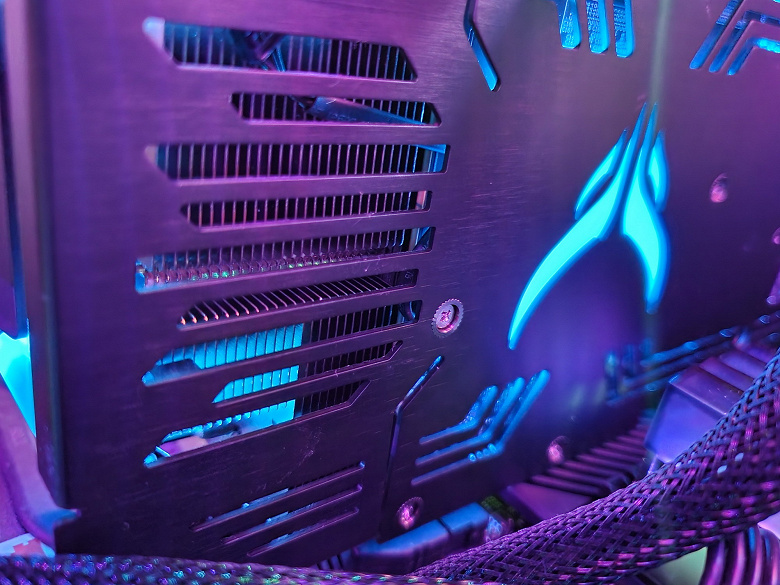
Let me emphasize once again that optimization of the settings for the operation of video cards for mining in our case does not provide for strong overclocking of the video memory, and external blowing of video cards is also mandatory.
conclusions
The PowerColor Red Devil Radeon RX 6800 XT Limited Edition (16 GB) is an excellent competitor in every respect to the flagship graphics cards based on the Nvidia GeForce RTX 3080 for games without ray tracing: in general, they are almost on the same level, the PowerColor card is even slightly more productive. It has a decent size due to the cooler, occupies 3 slots in the system unit, but the SO is quiet even in the more productive BIOS OC mode, not to mention BIOS Silent, in which the performance almost does not drop, and the cooler is practically inaudible behind the general background of a working computer.
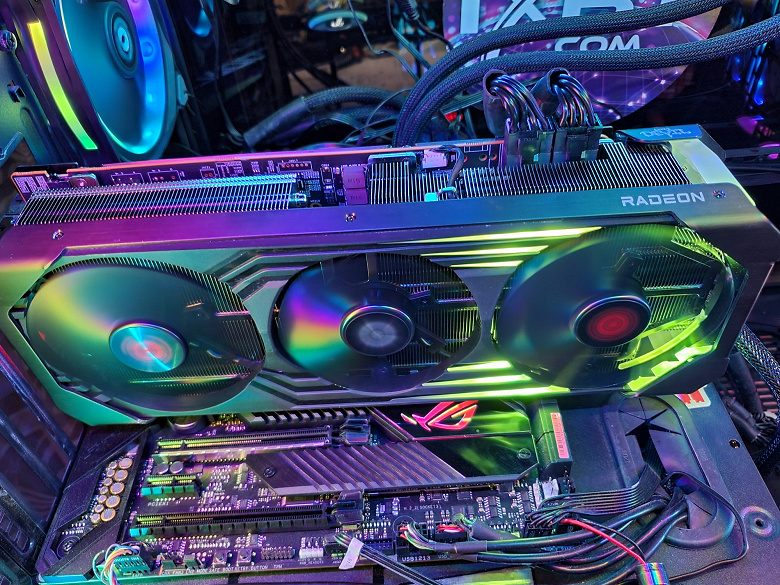
The reviewed video card has a very good power system, and manual overclocking provides a decent performance boost, even allowing it to catch up with the more expensive Radeon RX 6900 XT.
The PowerColor card has an AMD-recommended set of video outputs (2 DP + 1 HDMI + 1 USB Type-C) and is powered via a pair of 8-pin connectors. It is worth noting the beautiful and stylish backlighting with the ability to synchronize with the motherboard, as well as bonus keycaps for the mechanical keyboard included in the package.
Unfortunately, in games with ray tracing in the Radeon RX 6000 family, everything is still unhappy: the Radeon RX 6800 XT performs at the level of the GeForce RTX 3070 and is suitable for games with maximum graphics quality only at 2.5K resolution. If ray tracing is not provided in the game or is not enabled, then the Radeon RX 6800 XT will easily pull the maximum graphics quality in 4K resolution (in some games – even in 8K).
It should be traditionally reminded of the new AMD technologies accompanying the Radeon RX 6000 family, including support for the HDMI 2.1 standard, which allows you to display 4K-image at 120 FPS or 8K using a single cable, support for hardware decoding of video data in AV1 format, Smart Access Memory technology capable of providing small performance gains when the new accelerators work together with Ryzen 5000 processors (as well as with 10th Gen Intel Core processors on a number of motherboards). Also worth noting is the Radeon Anti-Lag latency reduction technology, which is useful for esports players.
The only drawback that we noted during testing: when you turn on the computer with any Radeon RX 6000 connected to a 4K @ 120 Hz or 8K @ 60 Hz TV, the software does not initialize correctly, and the picture disappears. You should turn off support for HDMI 2.1 on the TV (switch the port to HDMI 2.0 mode), then the picture will appear, and then you can turn on HDMI 2.1 mode back, the card will switch to the desired mode without problems. Tested on several TV models from different manufacturers: this is a purely AMD software bug.
They say that such cards are supposedly not very suitable for mining, providing too low performance compared to the competitor in the face of the GeForce RTX 3080. However, recently, these cards have started to cost about the same as the GeForce RTX 3070, which produces about the same hash rate. As a result, the widespread shortage, the greed for profit among dealers and the growing popularity among miners led to the almost complete loss of older Radeon RX 6000 from sale.
References :
In the Original Design nomination, the PowerColor Red Devil Radeon RX 6800 XT Limited Edition (16 GB) won:
The PowerColor Red Devil Radeon RX 6800 XT Limited Edition (16GB) received the following awards in the Excellent Package nomination :
Testbed : AMD Ryzen 9 5950X CPU courtesy of AMD , ROG Crosshair Dark Hero motherboard courtesy of Asus




